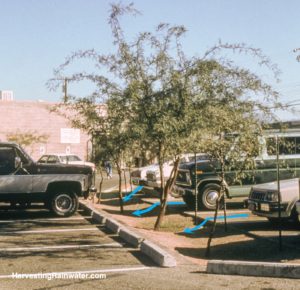Parking Lot to Parking Orchard

People get comfortable with, and inspired by, new ideas (such as water harvesting) when they experience working examples first hand. Your home site can present such an opportunity. Though a truly public site can maximize potential exposure, while sustaining privacy for yourself. Help turn a problem into a solution, and the idea can really take off.
Water harvester Dan Dorsey saw such an opportunity in the Tucson, Arizona Community Food Bank’s sun-baked asphalt parking lot in the 1990s. The lot was bleak, impervious, and contributed to significant flooding problems downslope when the rains came and all the stormwater rapidly ran off. Dan drew up a plan, presented it to the director, and got the go ahead.
A bunyip water level and spray paint was used to mark contour lines in the parking lot and around the building. Appropriate locations for infiltration basins were marked where they fit with contour lines, parking spaces and vehicular access. Heavy equipment precisely cut and removed the asphalt where marked, and dirt was excavated to form the basins. Then fifty 15-gallon (56-liter) sized low-water-use, food-producing mesquite trees were planted. Asphalt speed humps were installed to divert more runoff into the basins and slow parking lot traffic.
After one year, the trees could survive entirely on runoff from the building and remaining asphalt (Fig. 1). After three years some trees were 20 feet (6 m) tall. This greatly decreased the energy bills for cooling the building, and decreased stormwater flooding the street. The wavy shapes and cool green of the trees softened the sterile lines of the office building and created a pleasant and welcome place for people to park, work, and visit. Surrounded by an urban forest, people’s mood and demeanor seemed to relax.
Seven years later the Food Bank moved to a larger facility. The property was left vacant for years, yet the trees continued to grow, thrive, and inspire.
Resources:
• Water-Harvesting Parking Lot, Parking Garage, and Driveway Images.
• Mesquite pods as food. www.DesertHarvesters.org.
• “Swaling a Parking Lot in Tucson” by Dan Dorsey, Permaculture Drylands Journal, Number 30, Summer 1998, p 16.

Volume 1

